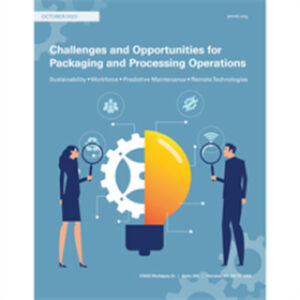Transforming Packaging and Processing Operations

The convergence of predictive maintenance and artificial intelligence (AI) has emerged as a game-changer, revolutionizing the way packaging and processing operations are conducted.
Innovations in Predictive Maintenance and Artificial Intelligence
By Tom Egan, vice president of Industry Services for PMMI, the Association for Packaging and Processing Technologies
The packaging industry has always been at the forefront of innovation, constantly evolving to meet the demands of consumers and optimize operational efficiency. In recent years, the convergence of predictive maintenance and artificial intelligence (AI) has emerged as a game-changer, revolutionizing the way packaging and processing operations are conducted. As stated in the Challenges and Opportunities for Packaging and Processing Operations report, produced by PMMI, The Association for Packaging and Processing, the integration of these technologies offers immense potential for cost savings, enhanced productivity, and improved overall equipment effectiveness (OEE). In this feature, we delve into the key innovations driving the future of packaging through predictive maintenance and AI.
The power of predictive maintenance

Predictive Maintenance is growing in popularity and use, with 43% of CPGs currently using it and 45% planning to use it in 3 years’ time according to the report, Challenges and Opportunities for Packaging and Processing Operations, produced by PMMI, The Association for Packaging and Processing.
Traditionally, packaging operations have relied on preventive maintenance, following a predetermined schedule of inspections and component replacements. However, this approach often leads to unnecessary downtime and costs, as maintenance is performed even when equipment may not require it. Predictive maintenance takes a more proactive stance, harnessing data-driven insights to predict and prevent failures before they occur.
One of the primary advancements in predictive maintenance is the Internet of Things (IoT). By equipping packaging machinery with sensors, it becomes possible to monitor various parameters in real time. These sensors collect data on temperature, vibration, pressure, and other vital metrics, which are then analyzed using machine learning algorithms. As a result, maintenance teams can identify patterns and anomalies, enabling them to intervene promptly and prevent equipment breakdowns.
Moreover, the integration of predictive maintenance with AI offers a higher level of accuracy and efficiency. Machine learning algorithms can analyze vast amounts of historical and real-time data to detect subtle patterns that human operators might miss. By continuously learning from data, AI-powered predictive maintenance systems become increasingly accurate over time, optimizing equipment performance, and minimizing unplanned downtime.
The role of AI in packaging
AI is revolutionizing the packaging industry in numerous ways. It enables the automation of complex tasks, enhances quality control, and streamlines production processes. Let’s explore some of the most impactful AI applications in packaging.
- Quality Control and Inspection: AI-powered vision systems can inspect packaging materials quickly and accurately, ensuring quality standards are met. These systems can detect defects, such as scratches, dents, or printing errors, in real-time, significantly reducing the risk of faulty products reaching the market.
- Intelligent Robotics: AI-driven robots are transforming packaging operations, increasing speed and precision. These robots can handle repetitive tasks like picking, placing, and packaging items, freeing human workers for more value-added activities. Advanced AI algorithms enable robots to adapt to changing conditions, making them highly versatile in various packaging scenarios.
- Supply Chain Optimization: AI algorithms can analyze vast amounts of data, including sales, inventory, and market trends, to optimize supply chain operations. By predicting demand patterns, AI systems help streamline inventory management, reduce waste, and ensure optimal stock levels. Additionally, AI-powered route-optimization algorithms optimize the delivery process, minimizing transportation costs and improving efficiency.
- Personalization and Customization: AI allows packaging manufacturers to cater to individual consumer preferences. By analyzing consumer data and preferences, AI algorithms can generate customized packaging designs and produce them efficiently. This level of personalization fosters consumer engagement, brand loyalty, and ultimately, increased sales.
Challenges and opportunities

One of the primary advancements in predictive maintenance is the Internet of Things (IoT). By equipping packaging machinery with sensors, it becomes possible to monitor various parameters in real time. These sensors collect data on temperature, vibration, pressure, and other vital metrics, which are then analyzed using machine learning algorithms.
While the advancements in predictive maintenance and AI present a promising future for the packaging industry, there are challenges to overcome. One of the primary obstacles is the collection and analysis of vast amounts of data generated by sensors and machines. This requires robust data infrastructure and analytics capabilities to ensure accurate predictions and preventive actions.
Furthermore, the implementation of predictive maintenance and AI requires skilled personnel who can manage and interpret the data effectively. Upskilling the existing workforce and attracting new talent with expertise in AI and data analytics will be critical for organizations to fully harness the potential of these technologies.
However, the opportunities presented by these innovations are substantial. According to PMMI’s report, companies adopting predictive maintenance and AI can expect significant cost savings, reduced downtime, and improved OEE. By preventing equipment failures, businesses can avoid costly repairs, maintain consistent production levels, and enhance overall operational efficiency.
Moreover, the integration of predictive maintenance and AI can lead to more sustainable packaging practices. By optimizing production processes, reducing waste, and improving resource management, packaging manufacturers can minimize their environmental impact and contribute to a greener future.
The packaging industry is undergoing a transformative journey driven by innovations in predictive maintenance and artificial intelligence. The convergence of these technologies enables organizations to unlock new levels of efficiency, productivity, and sustainability. By leveraging the power of predictive maintenance, packaging operations can transition from reactive to proactive maintenance approaches, significantly reducing downtime and costs. Furthermore, AI applications across the packaging value chain enhance quality control, improve supply chain management, and support personalized packaging experiences.
As PMMI’s report highlights, organizations that embrace these innovations stand to gain a competitive edge in an increasingly dynamic marketplace. With proper investment in infrastructure, talent development, and collaboration with technology providers, packaging companies can embark on a transformative path toward a more efficient and sustainable future. The possibilities are vast, and the time for embracing these innovations is now.
About the Author
Tom Egan serves as the vice president of Industry Services for PMMI, the Association for Packaging and Processing Technologies. He joined the PMMI staff in 2003 following more than 20 years in the packaging industry during which he was also an active PMMI member. His previous work experience includes tenures at Eaton Corp. and as Vice President, Marketing & Sales, for Hoppmann Corporation. He has an MBA from Baldwin-Wallace College, and a BEE in Electrical Engineering from Villanova University. There is no better place to gain insight into the latest innovations in predictive maintenance and AI than PACK EXPO Las Vegas (Sept. 11–13, 2023; Las Vegas Convention Center) Register or learn more at www.packexpolasvegas.com.








